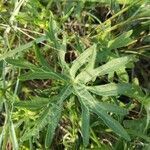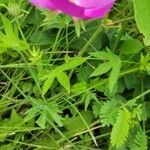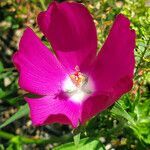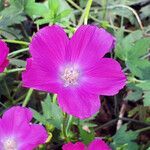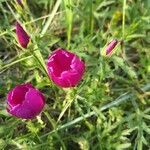Plants perennial. Stems 1–4, erect, 5–20 dm, appearing glabrous, but often sparingly hairy, hairs simple, glaucous. Leaves: stipules caducous, subulate, 6–8 mm; petiole 12–30 cm; blade suborbiculate, cordate, or ovate, (3–)5–10-lobed, 3.5–15 × 6–20 cm, surfaces strigose, lobes linear to lanceolate. Inflorescences paniculate; involucellar bractlets absent. Flowers bisexual; calyx lobes valvate in bud, forming apiculate or acuminate point; petals reddish purple with white basal spot, 1.8–3.1 cm. Schizocarps 8–8.5 mm diam.; mericarps 10–20, 3.5–4.5 × 2–3 mm, glabrous, indehiscent; beaks not prominent, 0.5–1.7 mm; collars absent or very weakly developed. 2n = 28.
A small herb. It is a deep rooted plant and keeps growing from year to year. It grows 20-50 cm high. The stems are grey-green. The leaves are alternate. The leaves at the base have leaf stalks about as long as the leaf. The leaves have deep lobes. There are few leaves on the upper part of the stem. The flowers have 5 petals and are cup shaped at first. They are red and 2.5-5 cm across. The stamens and pistil form a cone like structure at the centre of the flower.
